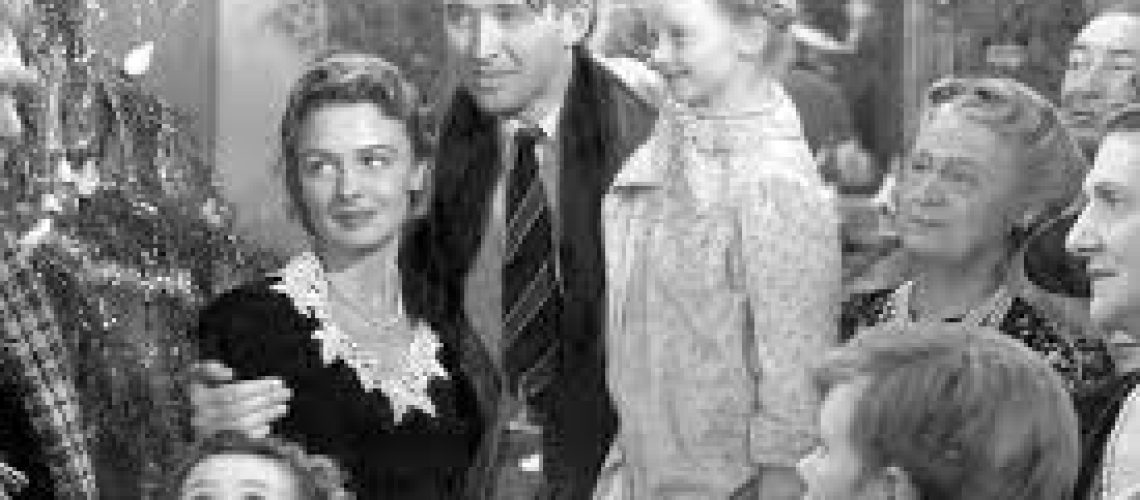It’s A Wonderful Life is my favourite Christmas movie. It holds up as an incredibly life affirming piece of art. As a socialist too, the film’s politics are shockingly progressive for what is the quintessential American holiday classic.
It’s A Wonderful Life follows a troubled man, George Bailey, who is contemplating taking his own life amidst sudden financial hardship. This is how the film starts. What follows is the audience being taken along the course of his life, from a young boy to the present day. George is an ambitious dreamer who wants to travel the world and become a successful architect – a prime example of the American Dream. However, he is continuously stopped by unfortunate life circumstances and his good nature refusing him to take the easy, selfish road.
George’s father runs the family Bailey Brothers Building and Loan but succumbs to a stroke. At that point, the film’s primary antagonist, Henry Potter, “the richest and meanest man in town” seeks to dissolve the bank, a vital help for the town’s working class not wanting to live in slums but is opposed by George. George, already late for college, is given an ultimatum: the Building and Loan can be saved but George has to stay behind to run it or else Potter will have his way. George makes the right choice and stays.
Despite being a generally good-natured person, George isn’t always an angel. He can be rash, temperamental and prone to temptation. But that is what makes him human. George has self-centered needs like any other person but what makes him stand out is that, from push comes to shove, he puts the greater good and the common interest over his own desires. This is best shown when Potter invites him into his office to give George a highly lucrative job offer. The thought is tantalising and George seriously considers it for a moment but he soon realises Potter for the devil he is and that wonder turns to disgust. This endearing trait combined with his flaws makes for a really interesting, nuanced main character. George keeps putting off his dreams for the sake of other people but it comes at a cost. This is the beauty of It’s A Wonderful Life. Behind the film’s feel good message is an underlying darkness of how ordinary people can get ground down by the hardships of life and the capitalist economy. The film’s director, Frank Capra, was a hardline Republican who hated the New Deal but he was still able to show the incompatibility of capitalism and selflessness. This led the FBI’s Los Angeles branch to compile a report in which they considered it to be communist propaganda.
After chronicling George’s life, the film arrives back at the present day. On Christmas Eve, George’s Uncle Billy misplaces a large sum of money which leads George to spiral into despair, thinking about the potential horrible consequences. At this point, George is a frustrated man, someone who has bled and bled until he has nothing left to give. It culminates in him contemplating suicide which is when his guardian angel, Clarance, appears. He shows George an alternate world where he never existed. The results are grim. Bedford Falls becomes Pottersville, the locals become nasty and distrustful, George’s brother dies at a young age in an accident and many other people suffer worse lives – all because George wasn’t there to help them. As Clarence says, “Strange, isn’t it? Each man’s life touches so many other lives. And when he isn’t around he leaves an awful hole, doesn’t he?”. We see this in our everyday lives. Each person is interconnected with their neighbour and no one lives in a vacuum. We all rely on one another to survive and thrive. George learns this in a very special way. Despite all the broken dreams, he realises his life is truly wonderful.
It’s A Wonderful Life excels not only in the plot and themes but also in the acting. Jimmy Stewart’s performance as George is one of the best from Hollywood’s Golden Age. You can see this when George sees his brother Harry come back to Bedford Falls after being away for a few years with his newly wedded wife. After learning that Harry has been given a great job opportunity, it slowly dawns on George that he will forever be shackled to Bedford Falls for the rest of his life. Stewart wears this devastating recognition on his face as he walks towards the family and has to turn back to the happy, reliable George everyone knows and loves. The rest of the cast is brilliant too, one notable star being Lionel Barrymore as Mr Potter. He expertly portrays the miserly, Scrooge-like figure and gives us an all too familiar look at selfish, individualistic capitalists.
Despite being one of my all time favourites however, the film is not perfect. I often cringe at the alternate fate of George’s wife, Mary, where she is leading a life as an unmarried librarian. Sometimes I laugh at how dramatic and serious that moment is portrayed as despite how banal it actually is. It reminds me that this is still a film from the 1940s with old ideas about the American nuclear family structure.
It’s A Wonderful Life still stands the test of time. It’s not an inherently socialist movie – ultimately it’s an idealistic tale of a small town American mom-and-pop business owner standing up to corporate power. But for the Marxists in the audience, it provides vital lessons. Firstly, the inevitability of the emergence of monopoly capitalism as small producers are pushed out of the market and large corporations make up a greater part of the economy. And secondly, the importance of collective action and realising that we all need each other. The final scene where the residents of Bedford Falls arrive to help George in his time of need after he’s come to realise the importance of his life is one of the most beautiful moments in any film I’ve ever watched.






